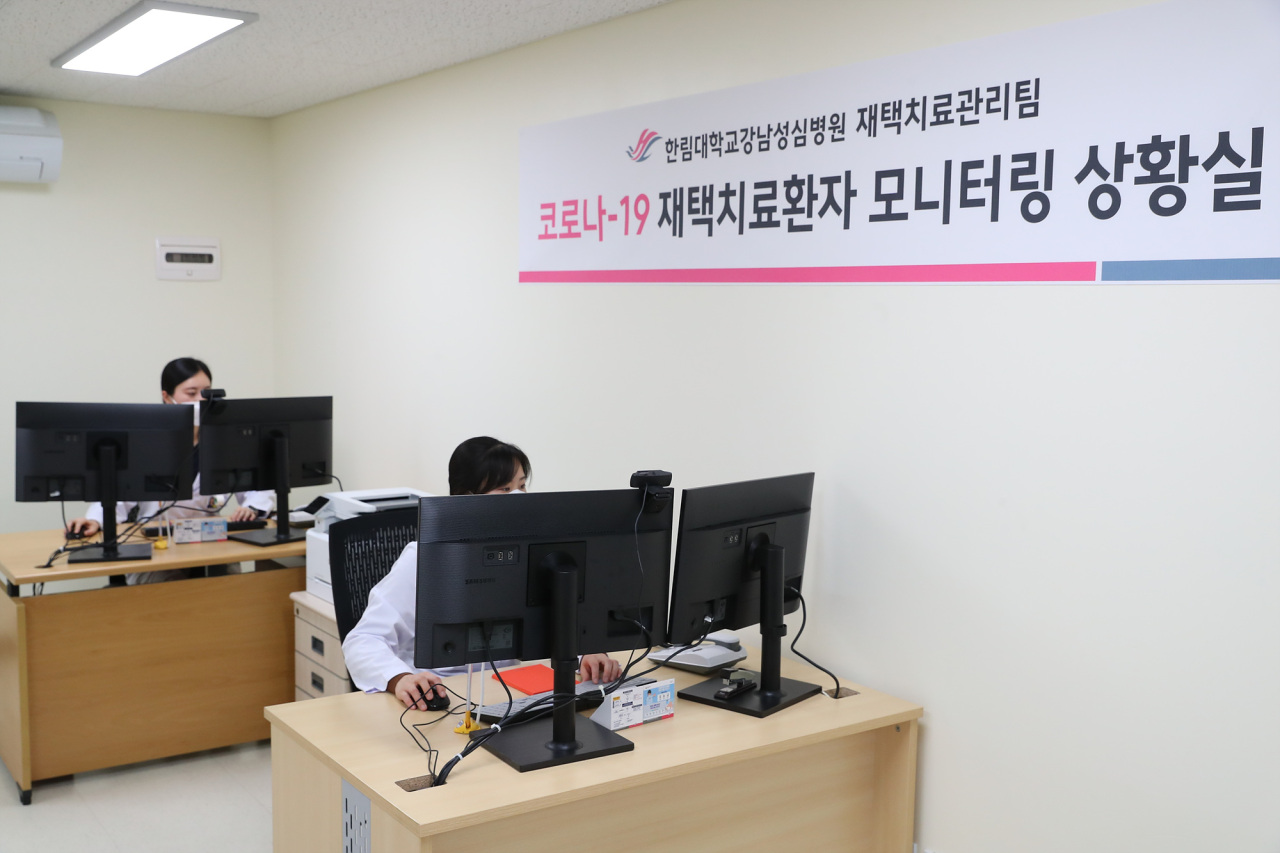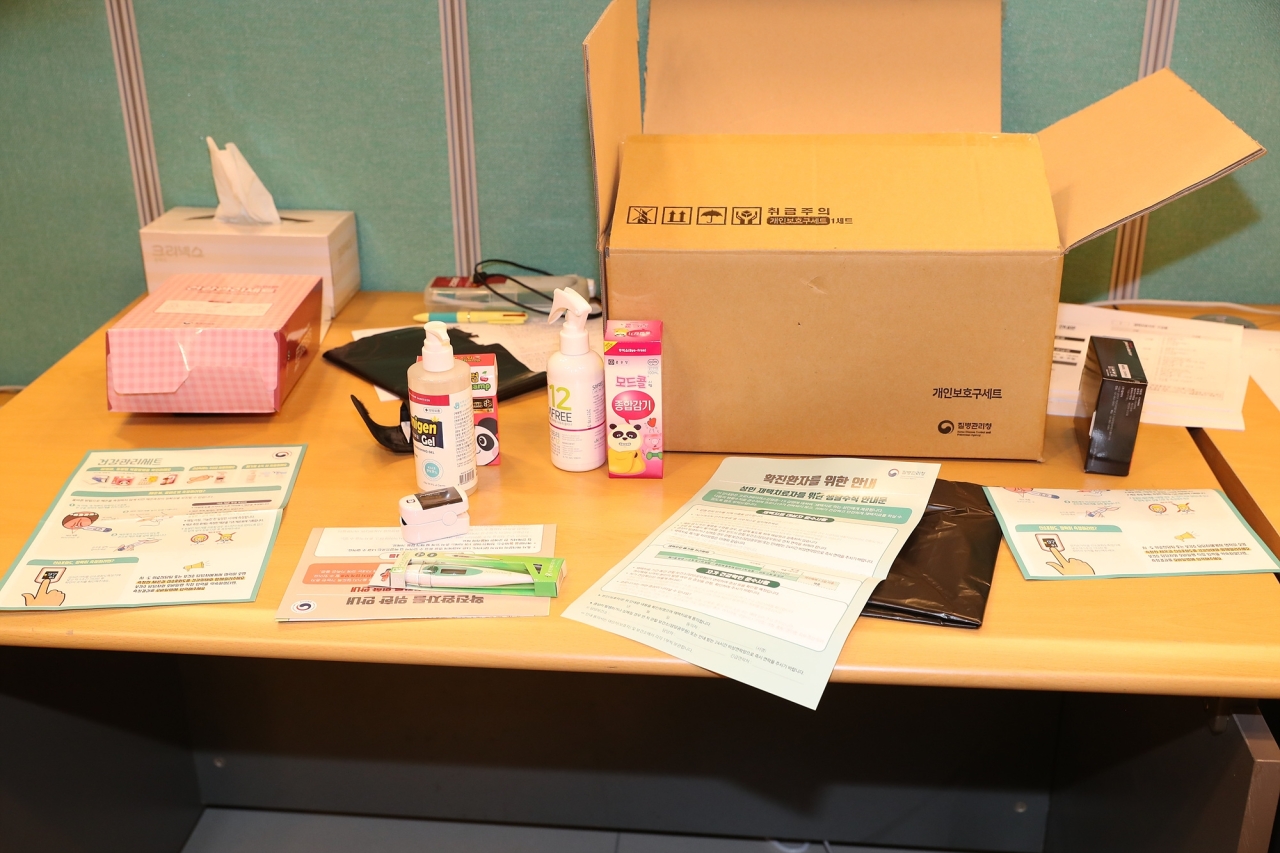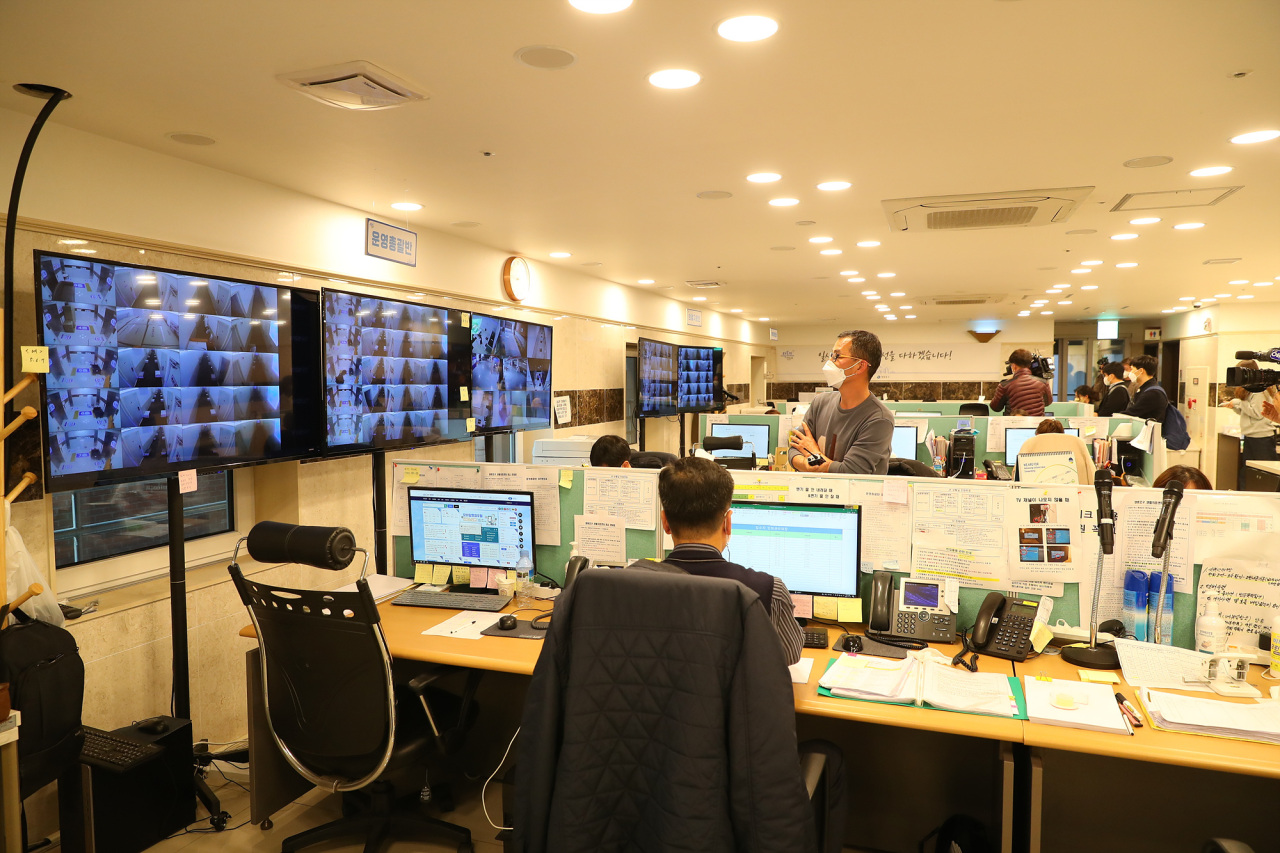 |
Health at Hallym University Medical Center give telephone consultations to Yeongdeungpo-gu patients in home isolation on Thursday. (Ministry of Health and Welfare) |
Health care workers in charge of looking after COVID-19 patients in home isolation are calling on authorities to ensure at least some hospital beds are kept aside for worsening cases, citing a lack of emergency provision.
As the recent surge fills hospitals, patients who were only minimally sick initially and prescribed home care are being left without a bed after their conditions rapidly deteriorate, they said.
In Korea, home recovery has been the default option for patients under 70 years of age without severe COVID-19 risk factors since Sept. 25. The minimum isolation period is 10 days after a positive test for patients who do not exhibit symptoms. For patients who do have symptoms, it’s 10 days since the day symptoms first appeared.
Lee Seung-chan, the Seoul Metropolitan Government official leading infectious disease control, said that until a few months ago the patient load fell solely on hospitals and nonhospital facilities for treating patients with asymptomatic or mild COVID-19 called community treatment centers. Now some of that burden is being lifted from the health care systems with at-home care.
“The home-care situation is not yet at a worrying level in Seoul,” he said. “But it may be wise to anticipate the possibility of patients being kept out of hospitals due to a lack of beds.”
The climb in infections since the country began returning to normal earlier this month is forcing an increasing number of patients to recover at home rather than at health care institutions. As of Saturday midnight, 5,118 patients considered to be still infectious were isolated at home across the country, 2,476 of them in Seoul.
In Youngdeungpo, southwestern Seoul, just seven officials are on rotating shifts to cover 24 hours a day. When The Korea Herald visited the home care management team’s office Thursday, there were 118 residents with COVID-19 staying at home. To accommodate more patients isolating at home, the district said it planned to increase staffing.
Lee said patients at home were asked to self-report their blood oxygen levels and body temperatures three times a day, using devices handed to them by the city.
The safety tool kit for home care patients, delivered to their doorstep within days of their diagnosis, includes a pulse oximeter, digital thermometer, and over-the-counter cold medicines and fever reducers. Gloves and other personal protective equipment are also provided if people living in the household as the patient are not infected with COVID-19.
 |
Items including a thermometer, pulse oximeter, cold medication and fever reducers are handed out to children with COVID-19 isolating at home. (Ministry of Health and Welfare) |
According to the guidance, an oxygen saturation level of 94 percent or below warrants emergency medical attention, Lee explained, while readings ranging between 95 and 100 percent are deemed normal.
Youngdeungpo has teamed up with Hallym University Medical Center, a secondary hospital in the district, for the remote patient monitoring.
Dr. Lee Jacob, an infectious disease specialist heading the hospital’s at-home patient monitoring program, said as patient numbers are projected to grow, hospitals will need to be able to allocate staffing and resources flexibly.
He said currently, there were four nurses making and receiving phone calls to see how patients are doing between 9 a.m. and 10 p.m. Each patient would get two calls from one of the nurses -- one in in the morning and another in late afternoon. After 10 p.m. patients can contact nurses on night watch, the hotline provided by the district, or 119.
In the event of an emergency, the nurse puts the patient through to one of the five doctors in charge -- four infectious disease specialists and one pediatrician. He said that in the last month, there have been “a few instances” where a doctor had to reach out to patients reporting breathing difficulties or other warning signs after midnight. On average, a doctor will consult up to 10 patients a day on worsening symptoms.
He warned that as eligibility for home recovery expands, it would be hard for a single hospital to respond to cases requiring emergency hospitalizations, referring to one patient in her 50s who had to travel to a hospital in another city because none of the nearby hospitals had beds to offer.
Her oxygen saturation had dropped to 88 percent in the hours since she was last checked via phone. Although an ambulance had gotten to her, no hospital in the vicinity could take her in. She had to spend a couple of days at one of the three negative-pressure rooms at the hospital’s emergency care center until a bed opened up at a hospital in Bucheon, Gyeonggi Province, about 20 kilometers away.
Asked how common such cases are, he said that, as more COVID-19 patients are being cared for in non-health care settings, one concerning phenomenon to look out for was this mismatch in symptoms “also known as happy hypoxia, in which patients’ outward symptoms do not match their actual low oxygen saturation levels.”
“Personally, I believe that all health care institutions from clinics to hospitals in the district will need to be mobilized to meet the demands as more patients are expected to be assigned to home care,” he said. He said hospitals did not have the capacity to keep extra beds aside in case home isolation patients need to be admitted.
 |
Officials of Yeongdeungpo-gu’s home care patient management team are at work Thursday afternoon. Their office is set up at the district’s community treatment center. (Ministry of Health and Welfare) |
In late October, a Seoul patient in his 60s who was isolating at home died while he being transported from hospital to hospital to find a bed. The man, who was without preexisting medical conditions, developed shortness of breath less than a day after he was diagnosed.
Son Gwang-soon, another official at Seoul’s infectious disease control division, said that while an ambulance may be dispatched to the patient, they might not be able to find a bed right away. But “nighttime COVID-19 emergencies have not occurred too frequently” to date, she added.
Kim Sun-mi, a nurse who has worked at the hospital for 10 years, said over-the-phone consultations “naturally take much longer than in-person sessions.” She said it took the four-nurse team took roughly two hours check on all of the 100-something patients undergoing home isolation in the district.
She said that there have been some patients who report feeling unwell and asking to be transferred to a facility. Before the city can decide whether to admit that patient, health care workers are required to offer their opinion on whether hospitalization is necessary. Ultimately, the government COVID-19 response headquarters is in charge of assigning beds.
Kim Ji-yeon, director of the Ministry of Health and Welfare’s at-home COVID-19 care division, said in principle patients should be able to whether to stay at home or treated a facility, but that depended on bed availability at a given time.
“Letting patients choose is the protocol, but how beds are assigned can only be affected by the number of open beds,” she said.
By Kim Arin (
arin@heraldcorp.com)









![[Exclusive] Hyundai Mobis eyes closer ties with BYD](http://res.heraldm.com/phpwas/restmb_idxmake.php?idx=644&simg=/content/image/2024/11/25/20241125050044_0.jpg)
